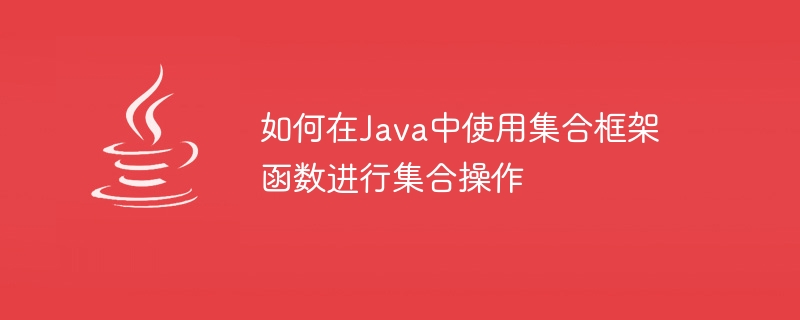Home >Java >javaTutorial >How to use collection framework functions for collection operations in Java
How to use collection framework functions for collection operations in Java
- WBOYWBOYWBOYWBOYWBOYWBOYWBOYWBOYWBOYWBOYWBOYWBOYWBOriginal
- 2023-10-21 09:54:111464browse

How to use collection framework functions for set operations in Java
Collections are commonly used data structures in Java programming. They provide a convenient way to store and operate a collection Group object. Java's collection framework provides a wealth of functions to operate on collections, including addition, deletion, modification, search, sorting, filtering, etc. Below we will introduce some commonly used set operation functions and give specific code examples.
- Traverse a collection
In Java, we can use the following way to traverse a collection:
// 创建一个List集合
List<String> list = new ArrayList<>();
list.add("Apple");
list.add("Banana");
list.add("Orange");
// 遍历集合
for(String item : list){
System.out.println(item);
}- Find the maximum sum in the collection Minimum value
If the objects in the collection are comparable, we can use the max and min functions in the Collections class to find the maximum and minimum values in a set.
// 创建一个List集合
List<Integer> list = new ArrayList<>();
list.add(5);
list.add(2);
list.add(9);
// 查找最大值和最小值
int max = Collections.max(list);
int min = Collections.min(list);
System.out.println("最大值:" + max);
System.out.println("最小值:" + min);- Sort Collection
If we want to sort the collection, we can use the sort function in the Collections class to accomplish.
// 创建一个List集合
List<Integer> list = new ArrayList<>();
list.add(5);
list.add(2);
list.add(9);
// 排序集合
Collections.sort(list);
System.out.println("排序后的集合:" + list);- Filtering the collection
If we want to filter the elements in the collection, we can use the stream method combined with Lambda expressions to achieve it.
// 创建一个List集合
List<Integer> list = new ArrayList<>();
list.add(5);
list.add(2);
list.add(9);
// 过滤集合
List<Integer> filteredList = list.stream()
.filter(i -> i % 2 == 0) // 过滤出偶数
.collect(Collectors.toList());
System.out.println("过滤后的集合:" + filteredList);- Delete elements in the collection
If we want to delete an element in the collection, we can use the remove function.
// 创建一个List集合
List<String> list = new ArrayList<>();
list.add("Apple");
list.add("Banana");
list.add("Orange");
// 删除集合中的元素
list.remove("Banana");
System.out.println("删除元素后的集合:" + list);In addition to the above operations, the collection framework also provides more rich functions, such as adding elements, determining whether elements exist, intersection and union operations of sets, etc. By flexibly using these functions, we can easily perform various operations on collections and improve the efficiency and readability of the code.
To summarize, this article explains how to use collection framework functions to perform collection operations in Java and gives specific code examples. I hope readers can flexibly use these functions in actual programming to improve their programming skills and efficiency.
The above is the detailed content of How to use collection framework functions for collection operations in Java. For more information, please follow other related articles on the PHP Chinese website!

